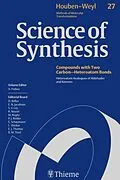Science of Synthesis provides a critical review of the synthetic methodology developed from the early 1800s to date for the entire field of organic and organometallic chemistry. As the only resource providing full-text descriptions of organic transformations and synthetic methods as well as experimental procedures, Science of Synthesis is therefore a unique chemical information tool. Over 1000 world-renowned experts have chosen the most important molecular transformations for a class of organic compounds and elaborated on their scope and limitations. The systematic, logical and consistent organization of the synthetic methods for each functional group enables users to quickly find out which methods are useful for a particular synthesis and which are not. Effective and practical experimental procedures can be implemented quickly and easily in the lab.// The content of this e-book was originally published in May 2004.
Autorentext
Albert Padwa
Zusammenfassung
Science of Synthesis: Houben-Weyl Methods of Molecular Transformations is the entirely new edition of the acclaimed reference series Houben-Weyl, the standard synthetic chemistry resource since 1909. This new edition is published in English and will comprise 48 volumes published between the years 2000 and 2008.
Science of Synthesis is a quality reference work developed by a highly esteemed editorial board to provide a comprehensive and critical selection of reliable organic and organometallic synthetic methods. This unique resource is designed to be the first point of reference when searching for a synthesis strategy.
Features:
- Contains the expertise of presently 400 leading chemists worldwide.
- Critically evaluates the preparative applicability and significance of the synthetic methods.
- Discusses relevant background information and provides detailed experimental procedures
For full information on the Science of Synthesis series, visit the Science of Synthesis Homepage
Series Editors: D. Bellus, S. V. Ley, R. Noyori, M. Regitz, E. Schaumann, I. Shinkai, E. J. Thomas, B. M. Trost, P. J. Reider
Inhalt
27.1 Product Class 1: Sulfur Ylides
27.2 Product Class 2: Alkylidenesulfonium Salts or α-Sulfanyl Carbocations
27.3 Product Class 3: Thioaldehyde and Thioketone S,S-Dioxides and Oxyimides (Sulfenes and Derivatives)
27.4 Product Class 4: Thioaldehyde and Thioketone S-Oxides and S-Imides (Sulfines and Derivatives)
27.5 Product Class 5: Thioaldehydes
27.6 Product Class 6: Thioketones
27.7 Product Class 7: Imines
27.8 Product Class 8: Iminium Salts
27.9 Product Class 9: N-Acylimines
27.10 Product Class 10: N-Acyliminium Salts
27.11 Product Class 11: Azomethine Ylides
27.12 Product Class 12: N-Haloimines
27.13 Product Class 13: Nitrones and Cyclic Analogues
27.14 Product Class 14: Nitronic Acids and Their Derivatives
27.15 Product Class 15: Oximes
27.16 Product Class 16: Azines
27.17 Product Class 17: Hydrazones
27.18 Product Class 18: Hydrazonium Compounds
27.19 Product Class 19: Azomethine Imines
27.20 Product Class 20: N-Nitroimines and N-Nitrosoimines
27.21 Product Class 21: Diazo Compounds
27.22 Product Class 22: Alkylidenephosphines
27.23 Product Class 23: Alkylidenephosphonium Salts
27.24 Product Class 24: Alkylidenephosphoranes
